The Twilight of the Indoor Mall
by Mike Nagel
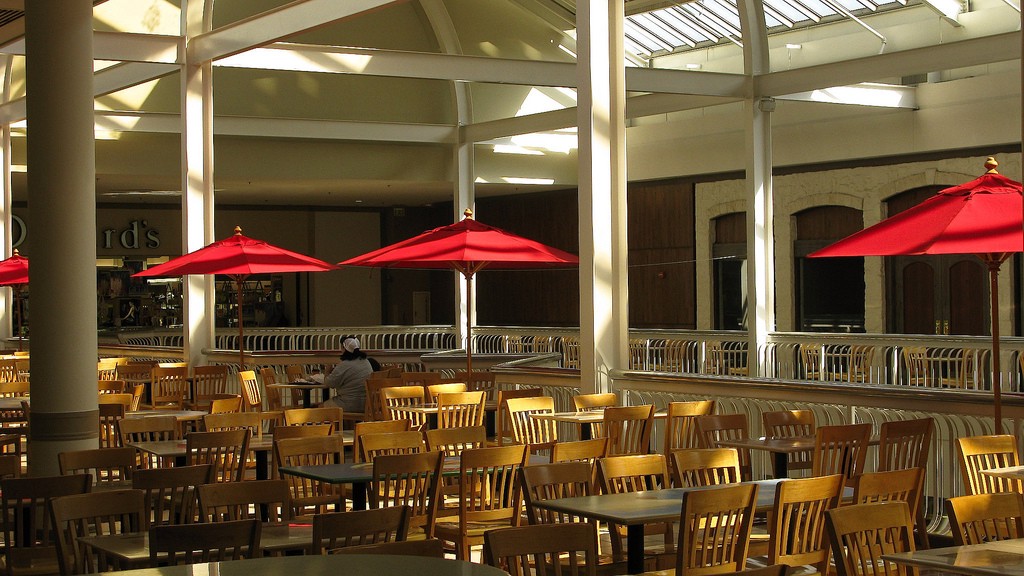
On Memorial Day weekend, one of the bigger shopping weekends of the year, I stopped by the Collin Creek Mall in Plano, a Dallas suburb. Sitting back about a quarter mile from the highway, the mall has a hundred and thirty stores, over six thousand parking spaces, and more than a million square feet of retail space. It is faceless, sprawling, silent; the exterior walls are fading beige brick. On the day that I visited, it looked like it was going to rain. A security guard in a golf cart endlessly looped the parking lot, which was nearly empty. I was here to see if the rumors, press reports, and Yelp reviews were true: that the mall was dying.
Pharrell’s “Happy” played over the hi-fi inside the mall. It echoed down the hallways, bouncing off the walls and overlapping with itself in weird, dissonant ways without the plush, shuffling bodies of shoppers to absorb some of the sound waves. There was almost nobody here. A woman with a clipboard asked me to answer a few questions: When’s the last time I purchased sunscreen? Bought athletic footwear? Went swimming? I answered her questions, but kept walking as she half-chased me down the hallway; there were twenty-five yards between us when she asked how old I am. I told her that I am twenty-six, and then realized why she was so persistent: There were around a hundred people in the mall, and at twenty-six, I was one of the youngest. The old people were everywhere: walking laps and playing cards and sitting on benches and staring off into space. None of them had a shopping bag.
I first talked to the guy who worked at the sunglasses stand just outside the food court. He looked about thirty years old. His hair was bleached, dyed purple, and cut at a slant, a style that I hadn’t seen since the early aughts. At first, he didn’t hear me; he was playing Angry Birds on his phone.
“Dude,” I said. “What’s going on with the mall?”
“The mall?” he said. He puts down his phone. “The mall.” He looked around. “The mall is dead, man.”
“Dead right now? Or like, dead for good?”
“Oh Christ,” he said. “I hope it’s not dead for good. Did you hear it was dead for good? I heard management’s got something up their sleeves.”
“Like what?”
He looked around to see if anyone was listening.
“A movie theater,” he said.

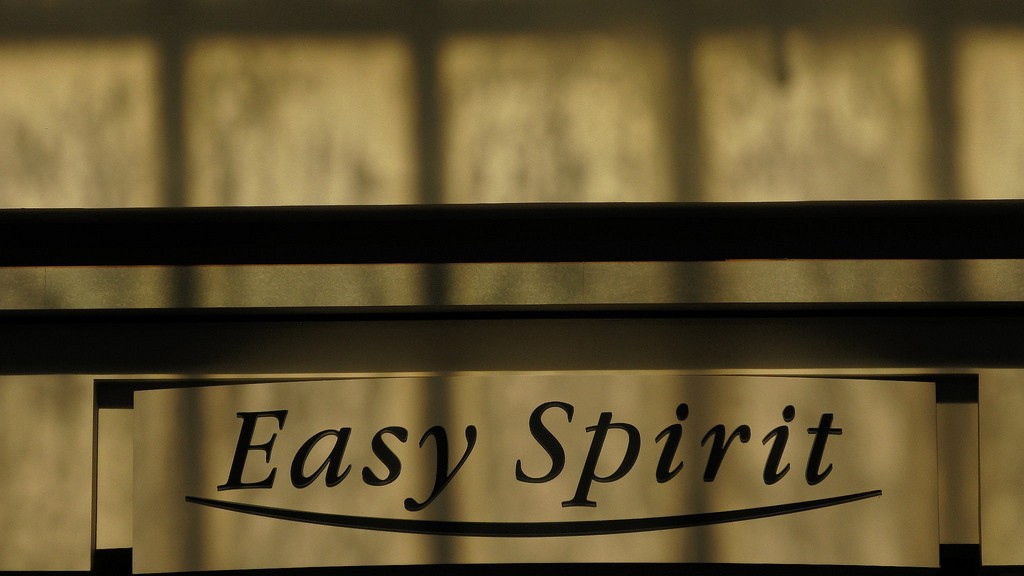
I walked further into the mall, looking for someone who could explain what was happening to the mall I had been coming to since I was a teenager. When I talked to a woman at “Sassy Diva,” I was the only person in the store. The woman, who seemed maybe fifty years old, unfurled a map with a top-down view of the mall and started crossing out stores that had closed after Dillard’s abandoned its space; they had names like “Glitter” and “Hi-Kick.” She drew a shaky circle around a blank, blue square in the top right corner of the map. “This is the dead zone now,” she said. “I don’t know how long stores in that area are going to last.”
“How long do you think your store is going to last?” I asked.
“I’m not worried,” she said. “As long as Forever 21 is here, we’ll be OK.” She threw her head to the left. The Forever 21 was filled with teenage girls and bargain bins.
“Have you heard rumors about a movie theater?” I asked.
“Oh yes,” she said. “Everyone has.”
“Where’d you hear that from?”
She pointed to the salon across the way. “But don’t tell her I told you,” she said.
The salon was empty too. There were a dozen hair-cutting stations but only a single employee — the owner, who sat at the front desk. Her face drooped slightly when she talked, making her mood impossible to read. She told me that she’s worked in Collin Creek Mall since 2003. Back then, she had trouble finding places to park.
“Now look at it,” she said. “Saturday night. No one here.”
I asked her where the people have gone.
“Better malls,” she said. “Stonebriar, Watters Creek, Firewheel. Why would anyone come here?”


In the nineteen fifties, people with money began leaving the cities in unprecedented numbers. They were getting married, getting jobs, starting families, and buying houses — they were moving to the suburbs. A Time Magazine article in 1954 observed: “…since 1940, almost half of the 28 million national population increase has taken place in residential suburban areas, anywhere from ten to 40 miles away from traditional big-city shopping centers. Thus, to win the new customers’ dollars, merchants will have to follow the flight to the suburbs.”
They did, and the suburban shopping mall was born.
But the original idea for the mall was not just about retail. Victor Gruen, the father of the suburban shopping mall, envisioned something much bigger. He wanted outdoor areas, banks, post offices, and supermarkets; he wanted to give the suburbs a soul, one inspired by the public squares of European cities. But that never happened. Instead malls were faceless, sprawling. Gruen was so disappointed with what malls became, he gave a speech in 1978 in which he said, “I refuse to pay alimony for those bastard developments.” Malls turned out to be the very monoliths of soullessness that Gruen had tried to overcome.
It’s not just that there are better malls than Collin Creek in the Dallas area. It’s that there are so many malls; Dallas has more shopping centers per capita than any other city in the United States. And according to some estimates, fifty percent of indoor malls nationwide will die over the next two decades — partly because some shoppers are opting for newer, better malls, but also because, as a recent Guardian article put it, “the middle class that once supported” mid-market malls is dwindling. Or, put yet another way, by retail consultant Howard Davidowitz: “What’s going on is the customers don’t have the fucking money.” Which, of course, wasn’t always the case.
As these old malls die off, they’re being replaced more and more by upscale, outdoor shopping centers — with lofts, grocery stores, offices, public meeting areas, and day cares. At least four have popped up in Dallas within the past ten years, and they’re always packed. Sixty years after Gruen’s ideas were bastardized by short-sighted developers, they are finally seeing their day. Inklings, maybe, of the suburbs finding their soul.

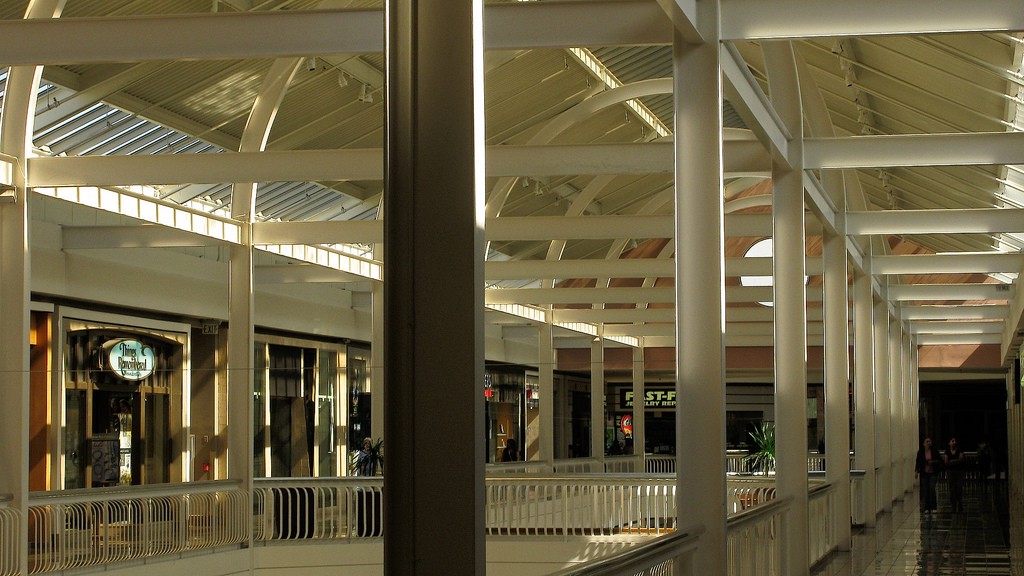
It took more than a week for someone at the Collin Creek Mall PR office to call me back after I had left a message asking if the mall was going to die. Matthew, an employee at a PR firm called Integrated Corporate Relations, the firm that represents Rouse Properties, which owns Collin Creek Mall, called me from Boston. I told him that I was in Collin Creek Mall over Memorial Day weekend and that it was pretty dead; I told him about the empty parking lots, the abandoned spaces, the old people walking in circles, and the dead zone. He thanked me for my interest in the mall.
“Rouse Properties is absolutely committed to creating a great mall experience that meets the ever-changing needs of the community,” he said, reciting the copy from the Collin Creek Mall website. “Collin Creek Mall is no different. We will certainly take your concerns into account.” When I asked him if Collin Creek Mall is going to close, he told me that he has no news to share on that front. I asked him if other Rouse Properties malls are struggling right now too; he said that was not information he was at liberty to share. “Are there any other questions I can answer for you?” he asked. I told him no, and thanked him for calling me back.
“Wait,” I said, just before he hung up. “I do have one last question. How are the plans coming for the movie theater?”
There was a pause.
“I have no news to share about that,” he said.
“Are there plans to build a movie theater?” I asked.
Another pause.
“I am not aware of there being any plans to build a movie theater,” he said.
“What’s the plan then?”
“I have no news to share about any plans.”

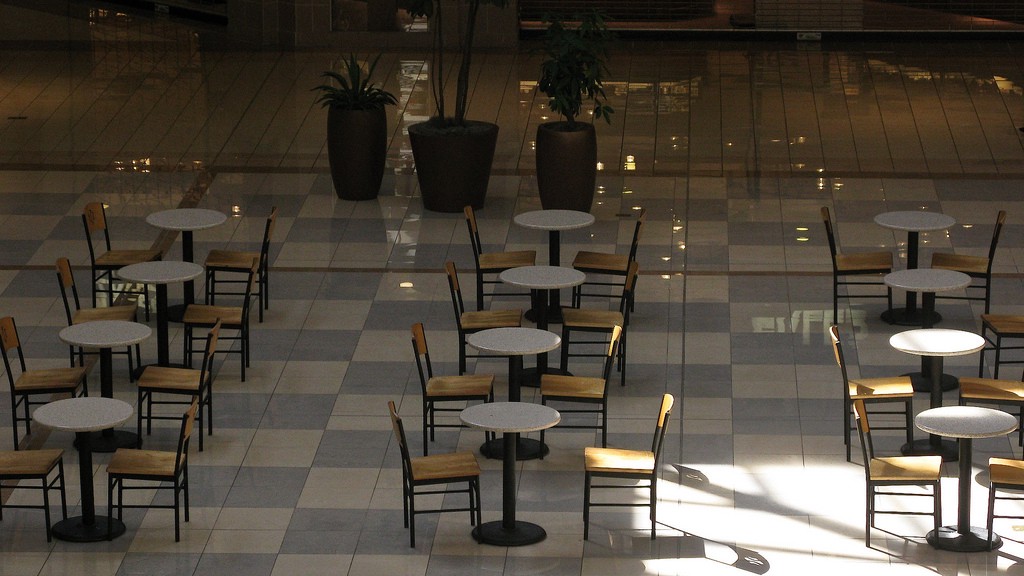
Here’s what happens when a mall like Collin Creek Mall dies. After its first major anchor pulls out, stores around it continue to close, slowly but persistently, one at a time, year after year. The remaining stores rearrange, consolidate space, move closer to the entrances. The mall becomes depressing, yes, but it’s still viable. Eventually, though, another anchor decides to pull out. Maybe it’s Macy’s. Maybe it’s JC Penny. Another cavity forms, another dead zone. Foot traffic gets ligher. Management doesn’t tell anybody anything about the future of the mall, because management won’t tell anybody anything until the day they decide to close the mall for good. Stores hear rumors from other stores. Basic upkeep starts to slip. The floors get dirty. The plants die. The mall starts to smell. When two anchors leave, “that’s typically the beginning of the downward spiral leading to ultimate extinction,” Cedric Lanchance, director at a real estate analytics firm, said in a Business Insider article. “Most struggling malls don’t go down without a long, drawn-out fight, however — the evidence of which exists in hundreds of communities across the country where vacant wings of various shopping centers are beginning to crumble and decay.”
It could take years for the management company to finally call it quits, but eventually it won’t have a choice. A final date is announced. Summer sales become liquidation sales. Liquidation sales become closing sales. The last few remaining tenants are asked to leave, but most will stay open until the final day, selling not just remnant merchandise but pieces of the store. Local retailers will cannibalize the remains. Sections of the mall will be roped off. Mall walkers continue puttering around until the last possible moment. They walk laps in shorts and tennis shoes and neon pink visors. People show up with cameras. They post walkthrough videos on YouTube; they’re rarely sympathetic. Then, one day, the mall will close. Its doors will be locked and blacked out and no one will be allowed inside. That’s when the real decay will begin. Leaks form in the celling. Water gets in through the tiles. Mold spreads. Shattered glass from looters covers the floor. The ceiling caves in. Insulation hangs down, pink and poisonous. Displays that no one bothered to disassemble rot and crumble. The concierge kiosk collapses. Indoor plants that happen to have been planted beneath skylights continue to grow, outgrow their planters, crawl out onto the floor, creep through the mall.
The damage might not stop there. “When a mall closes, unemployment rolls in the region swell, and the loss of property, sales, and business taxes can leave municipalities with serious shortfalls,” The Week notes. “The city of North Randall, Ohio is nearly bankrupt following the closing late last year of the Randall Park Mall, once the largest mall in the Cleveland area. ‘It could simple cease to exist as a city,’ says Cuyahoga County Commissioner Peter Jones.”
Death, it seems, is contagious.

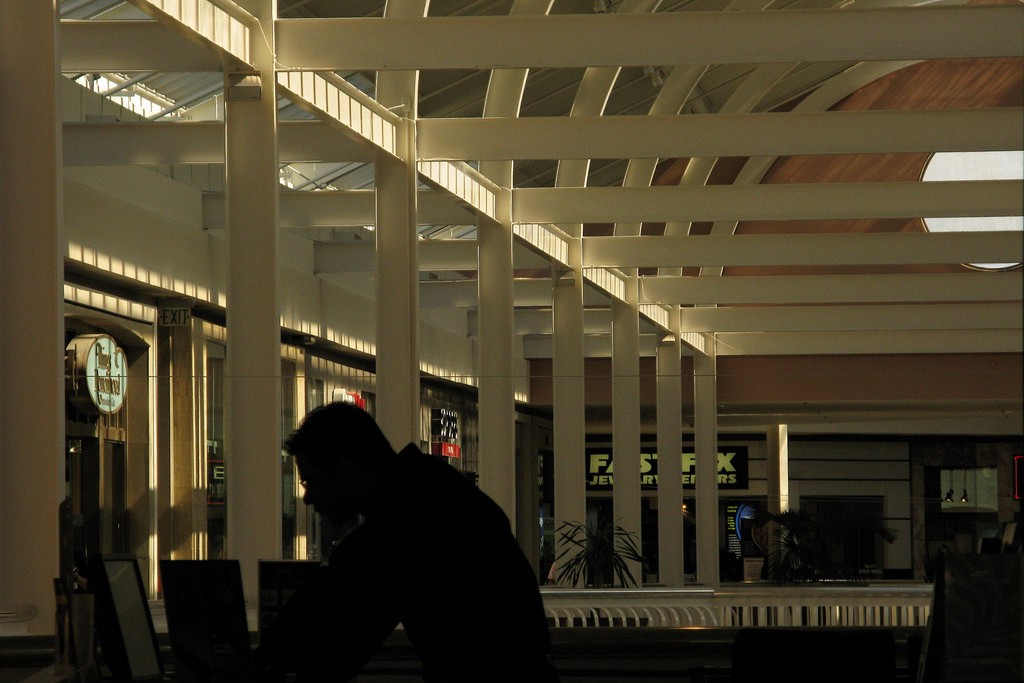
I went by the mall again on Wednesday night, the week after Memorial day. It was dim inside; no natural light poked through the skylights. There were fifty people, maybe less. The escalator was broken, so I took the stairs to the second story. I talked with Tim, the owner and operator of Heavenly Hands barber shop. The shop was empty. He was sweeping up in the back and he didn’t ask if I wanted a haircut. Tim is an older, bright-eyed man with a thick black beard. I asked how business is going, and he said business is good; he’s expanding. The store across the way just closed, so he’s opening a salon in the space.
“A salon,” he told me, “brings in five times as much as a barber shop.”
I ask him if they’ve seen business drop off after Dillard’s left.
“Not really,” he says. “Most of our foot traffic comes from Sears. And besides. We have a very specific clientele.”
“Who’s your clientele?” I asked.
He looked at me like I was a moron. “Black people,” he said. “That’s how I knew you weren’t here for a hair cut.” Just then a kid walked into the store, threw away his slurpee, and walked back out again. “See that?” he said. “If that kid had been white, no way he’d walk in here just to throw his slurpee away. No way. People know where they belong.”
Tim and I talked for an hour about barber shops and his strategies for bringing in customers; how he puts up posters in the windows of people with haircuts his staff could never recreate. “In a mall,” Tim said, “You have three seconds to capture someone’s attention. They walk by, look inside, make a decision.”
I ask if he’s worried about the mall dying.
“I’m not,” he said. He heard they have a plan: a movie theater where the Dillard’s used to be. “Because right now,” he said, “that’s the dead zone. That’s the Dillard’s dead zone. Nothing can survive over there right now.” When I got up to leave, the mall was closing for the night. The storeowners were pulling down the metal barriers; the lights were shutting off in sections; darkness moved from one side of the mall to the other. A security guard walked by and told me it’s time to go.

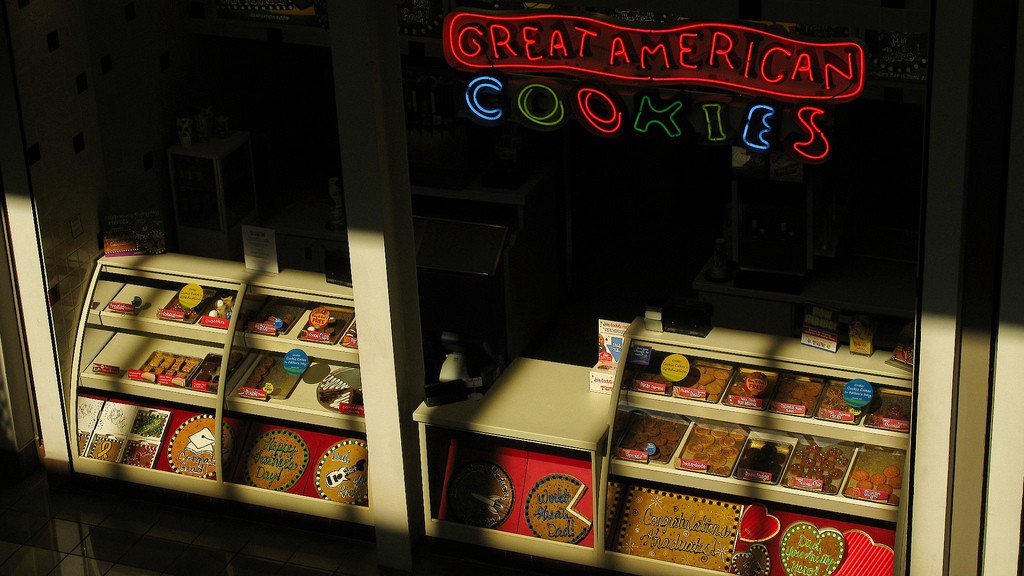
I came back on Saturday and the parking lot was so hot that the black asphalt stuck to my shoes. I walked to the Dillard’s dead zone and sat on the edge of a concrete planter. In front of me, a kids’ playground sat unused, the color draining out of the plastic. The doors to Dillard have been locked and blacked out. You can’t see inside. Behind them are a hundred and seventy-six thousand square feet of empty space. Next to Dillard’s were the remains of a mattress store. On the opposite side, a Regis hair salon was open but empty. I talked to the guy at the counter. I asked him if he knew he was in the dead zone.
“Of course I know I’m in the dead zone,” he said, “I’m in the dead zone,”
He told me that almost everyone in the dead zone is trying to get out of their lease. I asked him if Regis is trying to get out of their lease too. He said he probably shouldn’t talk about that, but then told me he doesn’t really know anything anyway. “All anyone ever hears are rumors. Then one day stores disappear.”
I asked him which store he thought would disappear next, and he told me what everyone else had told me: “That big-ass shoe store down there by Macy’s.” Nobody could remember its name. In a mall, a store isn’t known by its name. It’s known by its location, which I now realize is the only thing that matters. There were a couple shoe stores by Macy’s, but only one that I would call “big ass”: a shoe store called Encore, a wall-to-wall emporium of shoes and shoe displays and shoe benches with those slanted mirrors underneath. A No Doubt music video was playing on a TV in the corner. Boxes were stacked chest high and two deep. There must have been thousands of pairs of shoes here. I counted seven customers. Employees walked around with blank looks on their faces and customers moved slowly. The signs for fifty-percent-off sale were bright red.
An employee in a bright red polo shirt asked me if I needed help finding anything. His sleeves were stretched around his biceps. His hair was bleach blonde and spiked, and he wore a puka-shell necklace; he looked like one of the few types of people who still belong in a mall like this. I told him I was fine, and he snapped his fingers and walked away. A Jack Johnson song was playing now. A forty-year-old dad in a pink polo was trying on a pair of New Balance tennis shoes. A pre-teen was texting with one hand on her hip. A manager was slicking back his hair. These are the holdouts, the ones left behind. They don’t seem to notice that they’re the only ones here, or that this place is falling apart around them. This isn’t just the end of a mall, it’s the end of an era.
I didn’t come back to the mall for a month. When I did, on a Thursday afternoon, the mall was the emptiest I had ever seen it. In the month since I’d been there, the mall had continued to fade. Faster than I’d expected, actually. Most of the people I’d talked to were already gone. The Regis hair salon had disappeared. “Closed about a month ago,” the woman at the shop next door told me, just a few days after I’d stopped by. The sunglasses stand had been wiped clean. The woman at “Sassy Diva” had quit or been fired. Encore was still around. Tim at the Heavenly Hands barbershop was doing okay. He had just opened his salon, and when I went in to say hi, he was talking strategy with one of his stylists. He smiled and gestured around at his new place. It was new, bright, shiny, and completely out of place in Collin Creek Mall.
All photos copyright John Prichard, who was once chased out of Collin Creek Mall. Used with permission.
